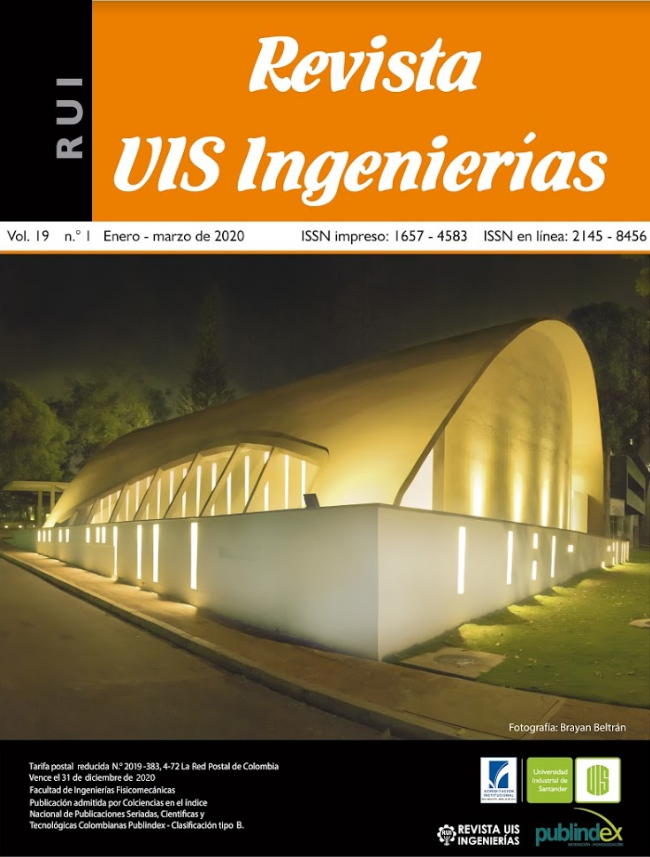Synthesis and optimization of properties of thin films of FAx(MA1-X)PbI3 grown by spin coating with perovskite structure to be used as active layer in hybrid solar cells
Published 2020-01-03
Keywords
- chemical composition,
- methylammonium cation,
- formamidinium cation,
- antisolvent treatment
How to Cite
Copyright (c) 2020 Revista UIS Ingenierías

This work is licensed under a Creative Commons Attribution-NoDerivatives 4.0 International License.
Abstract
This work reports results concerning the effect that the substitution of the methylammonium cation by the formamidinium cation causes on the properties of FAx(MA1-x)PbI3 films synthesized by spin coating in one step. For that, it was conducted a study to establish the influence of the composition of the FAx(MA1-x)PbI3 films on their optical, structural and morphological properties, determined through spectral transmittance, atomic force microscopy, and x-ray diffraction measurements. Correlating parameters of synthesis with results of the study of properties performed, it was able to get conditions to grow FAx(MA1-x)PbI3 films with an improved optical gap, microstructure and morphology, what allows to think that this compound is suitable to be used as the active layer in hybrid solar cells.
Downloads
References
[2] N.G. Park. “Organometal perovskite light absorbers toward a 20% efficiency low-cost solid-state mesoscopic solar cell”, Journ. Phys Chem Lett, vol. 4, pp. 2423-2429, 2013. doi: 10.1021/jz400892a.
[3] S. Kazim et al., “Perovskite as light harvester: A game changer in photovoltaics”, Angew Chem Int Ed Engl, vol. 53 pp. 2812-2824, 2014. doi: 10.1002/anie.201308719.
[4] J.H. Heo et al., “Hysteresis-less inverted CH3NH3PbI3 planar perovskite hybrid solar cells with 18.1% power conversion efficiency”, Energ Environ Sci, vol. 8, no. 5, pp. 1602-1608, 2015. doi: 10.1039/c5ee00120j.
[5] C. Chien-Hung, W. Chun-Guey, “Bulk heterojunction perovskite: PCBM solar cells with high fill factor”, Nature Photonics, vol. 10, no.3, pp. 196-200, 2016. doi: 10.1038/nphoton.2016.3.
[6] The National Renewable Energy Laboratory, “Best Research-Cell Efficiency Chart Photovoltaic Research,” NREL, 2018. [online] Available: https://www.nrel.gov/pv/cell-efficiency.html.
[7] M.M. Lee et al., “Efficient hybrid solar cells based on meso-superstructured, organometal Halide perovskites”, Science, vol. 338, pp. 643-647, 2012. doi: 10.1126/science.1228604
[8] J. Burschka et al., “Sequential deposition as a route to high-performance perovskite-sensitized solar cells”, Nature, vol. 499, pp. 316-319, 2013. doi: 10.1038/nature12340.
[9] O. Malinkiewicz et al., “Perovskite solar cells employing organic charge-transport layers”, Nature Photonics, vol. 8, pp. 128-132, 2014. doi: 10.1038/nphoton.2013.341.
[10] S.D. Stranks et al., “Electron-hole diffusion lengths exceeding 1 micrometer in an organometal Trihalide perovskite absorber”, Science, vol. 342, no. 6156, pp. 341-344, 2013. doi: 10.1126/science.1243982.
[11] B. Conings et al., “Intrinsic thermal instability of Methylammonium Lead Trihalide perovskite”, Adv. Energy Mater, vol. 5, no. 15, pp. 1-8, 2015. doi: 10.1002/aenm.201500477.
[12] W. Xie, Y. Wang, X. Zhang, “Synthesizing conditions for organic-inorganic hybrid perovskite using methylammonium lead iodide”, Journ. of Phys and Chem of Solids, vol. 105, pp. 16-22, 2017. doi: 10.1016/j.jpcs.2017.02.002.
[13] The National Renewable Energy Laboratory, “Explanatory Notes for NREL’s ‘Best Research-Cell Efficiencies’ Chart.”, [online] Available: https://www.nrel.gov/pv/assets/pdfs/cell_efficiency_explanatory_notes.pdf
[14] G. Gordillo, C.A. Otálora, M.A. Reinoso, “Trap center study in hybrid organic-inorganic perovskite using thermally stimulated current (TSC) analysis”, Journ. Appl. Phys, vol. 122, no. 075304, 2017. doi: 10.1063/1.4999297.
[15] A. Ghada et al., “Effect of temperature on light induced degradation in methylammonium lead iodide perovskite thin films and solar cells”, Sol. Energy Mater. Sol. Cells vol. 174, pp. 566-571, 2018. doi: 10.1016/j.solmat.2017.09.053.
[16] S. Xu-Guang et al., “Effect of CH3NH3I concentration on the physical properties of solution-processed organometal halide perovskite CH3NH3PbI3”, Journ. of Alloys and Compounds, vol. 706, pp. 274-279, 2017. doi: 10.1016/j.jallcom.2017.02.256.
[17] Z. Yi et al., “Optimization of stable quasi-cubic; FAxMA1-xPbI3 perovskite structure for solar cells with efficiency beyond 20%”, ACS Energy Lett, vol. 2, pp. 802-806, 2017. doi: 10.1021/acsenergylett.7b00112.
[18] K. Nitu, P.L. Sanjaykumar, G.L. Jignasa, “Superior efficiency achievement for FAPbI3-perovskite thin film solar cell by optimization with response surface methodology technique and partial replacement of Pb by Sn”, Optik, vol. 176, pp. 262-277, 2019. doi: 10.1016/j.ijleo.2018.09.066.
[19] M. Saliba et al., “Incorporation of rubidium cations into perovskite solar cells improves photovoltaic performance”, Science, vol. 354, no. 6309, pp. 206-209, 2016. doi: 10.1126/science.aah5557.
[20] J. M. Frost et al., “Atomistic origins of high-performance in hybrid halide perovskite solar cells”, Nano Lett., vol. 14, no. 5, pp. 2584-2590, 2014. doi: 10.1021/nl500390f.
[21] W. Qiu et al., “An interdiffusion method for highly performing cesium/formamidinium double cation perovskites”, Adv. Funct. Mater.,
vol. 27, no. 28, 1700920, 2017. doi: 10.1002/adfm.201700920.
[22] R. Yogamalar et al., “X-ray peak broadening analysis in ZnO nanoparticles”, Solid State Commun, vol. 149, pp. 1919-1923, 2009. doi: 10.1016/j.ssc.2009.07.043.
[23] G. K. Williamson and W. H. Hall, “X-ray line broadening from filed aluminium and wolfram,” Acta Metall., vol. 1, no. 1, pp. 22–31, 1953, doi: 10.1016/0001-6160(53)90006-6.
[24] A. Murphy, “Band-gap determination from diffuse reflectance measurements of semiconductor films, and application to photoelectrochemical water-splitting”, Sol. Energy Mater. Sol. Cells, vol. 91, pp. 1326-1337, 2007. doi: 10.1016/j.solmat.2007.05.005.
[25] P. Kubelka and F. Munk, “Ein beitrag zur optik derFarbanstriche”, Zeitschrift fur Tech. Phys, vol. 12, pp. 593-601, 1931.
[26] B. Slimi et al., “Perovskite FA1-xMAxPbI3 for solar cells: film formation and properties”, Energy Procedia, vol. 102, pp. 87-95, 2016. doi: 10.1016/j.egypro.2016.11.322.
[27] Y. Li, et al., “Formamidinium-based lead halide perovskites: structure, properties, and fabrication methodologies”, Small Methods, vol. 2, no. 7, 2018. doi: 10.1002/smtd.201700387.

